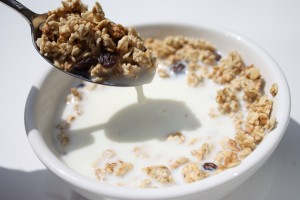 akfast cereal, by weight, when flake size is reduced, according to researchers from Penn State University.
akfast cereal, by weight, when flake size is reduced, according to researchers from Penn State University.The study, which was published in the March 2014 edition of the Journal of the Academy of Nutrition and Dietetics, found that when flake size was reduced by crushing people poured a smaller of volume of cereal into their bowls, but still took a greater amount by weight and calories.
“People have a really hard time judging appropriate portions,” said Barbara Rolls, Professor of Nutritional Sciences and Helen A. Guthrie Chair in Nutrition at Penn State University. “On top of that you have these huge variations in volume that are due to the physical characteristics of foods, such as the size of individual pieces, aeration and how things pile up in a bowl. That adds another dimension to the difficulty of knowing how much to take and eat,” she said.
The researchers said that national dietary guidelines defined recommended amounts of most food groups in terms of measures of volume such as cups.
“This can be a problem because, for most foods, the recommended amounts have not been adjusted for variations in physical properties that affect volume, such as aeration, cooking, and the size and shape of individual pieces.” Professor Rolls said. “The food weight and energy required to fill a given volume can vary, and this variation in the energy content of recommended amounts could be a challenge to the maintenance of energy balance,” she said.
Study method
The researchers tested the influence of food volume on calorie intake by systematically reducing the flake size of a breakfast cereal with a rolling pin so that the cereal was more compact and the same weight filled a smaller volume.
In a crossover design, the team recruited 41 adults to eat cereal for breakfast once a week for four weeks. The cereal was either standard wheat flakes or the same cereal crushed to reduce the volume to 80 percent, 60 percent or 40 percent of the standard. The researchers provided a constant weight of cereal in an opaque container and participants poured the amount they wanted into a bowl, added fat-free milk and non-calorie sweetener as desired and consumed as much as they wanted.
The research showed that as flake size was reduced, subjects poured a smaller volume of cereal, but still took a significantly greater amount by weight and energy content. Despite these differences, subjects estimated that they had taken a similar number of calories of all versions of the cereal. They ate most of the cereal they took, so as flake size was reduced, breakfast energy intake increased.
“When faced with decreasing volumes of cereal, the people took less cereal,” Professor Rolls said. “Yet, even though they thought they were taking the same number of calories, they ended up significantly overeating,” she said.
According to Professor Rolls, the findings of the study have implications for both portion selection and dietary advice. National guidelines for most food groups define recommended amounts in terms of volume, such as cups, but only a few adjustments are made for differences in food volume stemming from physical properties of food, according to Professor Rolls.
“There are a lot of variations in food volume that we’re not given much advice about,” Professor Rolls said. “Our research shows clearly that, without us even knowing it, these variations can have a big impact on how much we’re eating,” she said.
“For cereals with small pieces, the recommended serving size should be reduced to account for the uncharacteristically low volume, in the same way that the recommended serving size is increased for voluminous foods, such as puffed cereals and leafy greens,” Professor Rolls said.
Other authors on the paper include Jennifer Meengs, Laboratory Manager in Nutritional Sciences, and Liane Roe, Research Nutritionist in Nutritional Sciences.
The research was supported by the National Institutes of Health.







